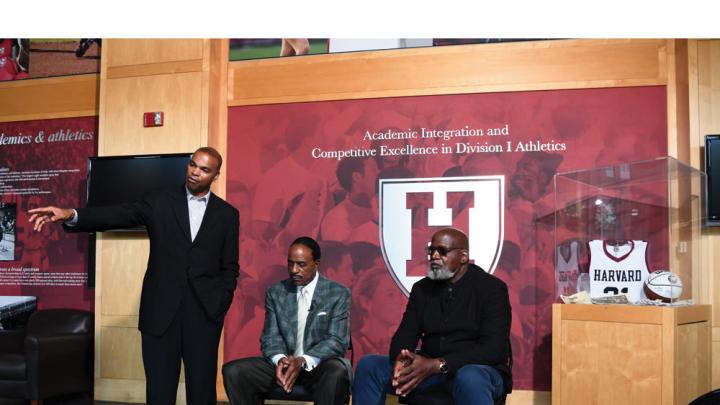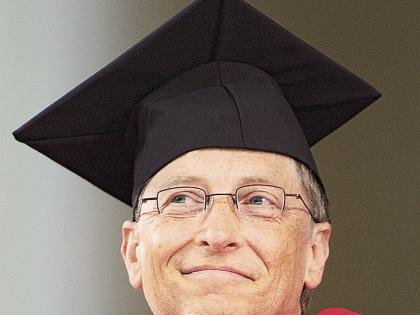On Wednesday evening, Stemberg men’s basketball coach Tommy Amaker sat off to the side in the front row at the Institute of Politics John F. Kennedy Jr. Forum, one of the listeners waiting to hear sports sociologist Harry Edwards and broadcaster James Brown ’73 discuss activism in sports. As the two men took the stage, Amaker rose to his feet, initiating a standing ovation that circled the audience, eventually encompassing his players and the 100-plus other attendees.
Amaker had spent a year encouraging Edwards to visit Harvard. The result was the evening’s talk, co-sponsored by the men’s basketball team, titled, “From Robinson to Kaepernick: The Evolution of Athlete Activism.” The conversation paid special attention to the recent wave of professional athletes taking a knee in protest during the pregame national anthem, a trend sparked by former San Francisco 49ers quarterback Colin Kaepernick, whom Edwards has mentored. Currently without a job in the NFL, Kaepernick has paid a price for his activism.
By standing to applaud and bringing the rest of the room with him, Amaker—rarely outspoken off the court—was signaling that Brown and Edwards had something important to say.
A few hours earlier, Amaker had stood in the Murr Center’s Hall of History, flanked by mementos of the University’s athletic tradition, including a trophy case with an autographed basketball, a jersey, and press clippings from his team’s recent NCAA successes. Amaker was there to introduce Edwards and Brown at a press conference that preceded the IOP event.
Edwards, a professor emeritus at the University of California, Berkeley, and a former discus thrower for San Jose State, established the Olympic Project for Human Rights in 1967, an organization intended to protest racial segregation. Most famously, the project advocated a boycott of the 1968 Olympics in Mexico City and inspired American athletes John Carlos and Tommie Smith to give a black-power salute on the Olympic medal stand. Edwards’s 1968 book Revolt of the Black Athlete is a seminal text and he has remained outspoken on issues of race in sports. On Wednesday, he recalled that a group of Harvard oarsmen on the Olympic crew had sent him a letter in 1968 expressing solidarity with his Olympic Project for Human Rights.
When Carlos and Smith raised their fists, James Brown was a senior at DeMatha Catholic High School, just outside Washington, D.C., and one of the most sought-after prep-school basketball prospects in the country. He had nearly committed to the University of North Carolina Tar Heels, coached by the legendary Dean Smith, but a letter from Harvard coach Bob Harrison, a former NBA All Star, gave him pause. So did the full-court press from a pair of prominent Harvard alumni: Senator Ted Kennedy ’54 and Representative John Culver ’54.
In the end, Brown chose Harvard, bypassing both North Carolina and UCLA. In his book, Role of a Lifetime, he writes that he made this choice in part to show other African-American athletes and students from modest backgrounds that attending a mostly white Ivy League school was possible. Especially in the aftermath of Martin Luther King Jr.’s assassination, and amid the civil-rights movement and Vietnam War, this felt important.
Unfortunately, Brown and his classmates—who formed the second-best recruiting class in the country that year—never realized their on-court potential. In part, Brown writes, the social upheaval of the late 1960s, a part of the players’ daily lives, likely also affected their performances: “These were politically and socially challenging times—the Vietnam War, the happenings at Kent State and other campuses, the Black Panthers—and I’m of the impression that we didn’t handle that transition as well as we might have under different circumstances.”
At the Wednesday press conference, Brown reflected on his time on campus, acknowledging the challenges of being away from home but emphasizing that it didn’t excuse the team’s lack of on-court success. (The Crimson came closest to capturing the Ivy League title during Brown’s sophomore year, when they went 16-10 overall and 11-3 in conference play.) Still, the Harvard team drew criticism from opposing coaches, who objected to the Crimson players’ long hair, including Brown’s afro—which often carried implications not only about appearance and discipline, but about the teams’ politics. A 1971 New York Times story, headlined “Harvard’s Hairy Five Makes Some Foes Bristle,” assured readers that despite his players’ hairstyles, Harrison was no “flaming liberal,” but merely “sensitive to the desires and rights of human beings.” In addition, as Brown wrote in his book, some opposing coaches—including Duke’s Hubie Brown and Penn’s Chuck Daly—“exhorted their players not only to win for Duke or Penn, but for the entire establishment of the United States and all that it stood for, as we—Harvard—stood on the side of chaos and anarchy.”
How much has changed since Brown arrived at Harvard in 1969?
There are parallels: wars abroad and upheaval at home over questions of race and equality. Last week in Cambridge, several faculty members—including Plummer professor of Christian morals Jonathan Walton, one of the team’s closest faculty advisors—were arrested while protesting the shift in federal policy toward those eligible for Deferred Action for Childhood Arrivals (DACA).
Meanwhile, the Harvard men once again have a collection of top-flight recruits and another prominent coach. There’s also this: within a year of Amaker’s hiring in 2007, The New York Times reported allegations that the University had lowered its admissions standards for his recruits and that the coach and his staff were violating recruiting rules to attract them to campus. Amaker and other Harvard officials deny these allegations and have suggested they spring from jealousy on the part of other Ivy League coaches. Some have also suggested that Amaker—Harvard’s only African-American head coach when he was hired—has been unfairly maligned because he is black.
On Wednesday, Edwards argued that the 1960s’ two fundamental challenges, “patriarchy” and “white supremacy,” remain the same—and unaddressed—even as the issues of the day (concussions, equity for women’s sports, and the legalization of marijuana nowadays) have shifted. The basketball team, he added, plays a significant role in addressing questions of race. “Basketball is still considered the quintessential black sport,” he said, “so anything happening in the African-American community in Boston generally, anything happening among African-American students on this campus, potentially at some point can interface with basketball. And, so, you want to always be aware of that broader community connection and that ethnographic political history of basketball and its emergence as the quintessential black sport.”
How is Harvard men’s basketball addressing these questions?
For one thing, Amaker talks openly with his players about difficult social issues. Junior Corey Johnson says the coach regularly distributes articles about current events and last year initiated discussions with the team when tensions broke out between law enforcement agencies and the African-American community.
Individual players are finding their voices too. Captain Chris Egi ’18, a black student whose parents immigrated to Canada from Nigeria, has been an active participant on social media to promote inclusion, including on #unfiltered, a site created by former Harvard player Zena Edosomwan ’17 to give students a platform to, as the website says, “tell your personal truth.” In one entry, Egi wrote, “As a black male, it’s easy to believe that you amount to nothing….I want to be that guy that young black boys look up to and say, ‘If he can do it, so can I.’”
In an interview earlier this week, Egi said he sees himself not as an activist but as “a conscientious citizen”—which he defined as “doing the right thing.” In that vein, he follows Amaker, whom Edwards ranked with prominent coaches he has worked with—including former San Francisco 49ers head coach Bill Walsh—who promote citizenship and engagement while succeeding on the court.
Tidbits
One of the attendees at Wednesday’s symposium was former Harvard basketball captain Ed Krinsky ’54, who helped bring Brown to Harvard. In 1969, after coach Bob Harrison expressed interest in Brown, Krinsky reached out to his classmates, Ted Kennedy and John Culver, and asked them to help recruit Brown. Until Wednesday, Brown and Krinsky had not met in person.
Brown and Edwards joined Amaker and other leaders from Harvard and the Boston area for the semester’s first meeting of Amaker’s “breakfast club.” The group—which consists primarily of black leaders and originated from a 2007 breakfast with Amaker and professors Charles Ogletree and Ron Sullivan—included Boston mayor Marty Walsh.
With less than one month to go before the men’s team’s Crimson Madness tipoff event, the renovation of Lavietes Pavilion is entering its final stages. On Wednesday, the men’s team worked out on the courts at Harvard Business School as the basketball programs await the opportunity to use the revamped facility.








